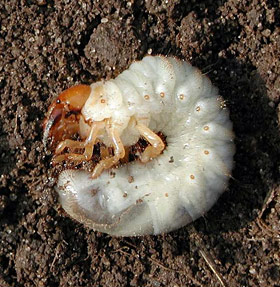White Grubs
White Grubs, larvae of the scarab beetle family, including Japanese beetle, Oriental beetle, Asiatic garden beetle, European chafers, May/June beetle, and masked chafers

David Cappaert, Michigan State University, Bugwood.org.
IPM Steps to Reduce White Grubs
1. Sample for Pest
Confirm the presence of white grubs before you treat.
Where to find it while inspecting: Scouting turf is very important to determine what species of grubs are present, their stage of development, infestation level, and distribution within the field. Walk in a zigzag pattern across the field, taking samples at 10–20 foot intervals from at least 10 locations. Begin sampling in August when grubs are easily seen and actively feeding, but before signs of injury are visible. Take square foot samples using a small shovel to cut through the turf and thatch on three sides of a square. Peel back the turf and inspect the thatch and upper 2–3 inches of soil. To find the grubs, shake the sample, and probe through the soil and roots with a pocket knife or screwdriver. Count the number and species of grubs found at each sampling site and record these on a map of the area. Replace the sod after sampling and irrigate thoroughly. A quicker method is to use a golf course cup cutter. This cuts a round core of about 1/10 square foot. Multiply the average grubs per core by 10 to get the approximate number of grubs per square foot.
White grubs are distributed in patches. Be sure to sample in the most likely turfgrass habitats. Japanese beetles and European chafers prefer grass in sunny areas, and high quality turf near the adult’s favorite food plants. May/June beetles often lay large numbers of eggs under or near exterior lights.
2. Proper ID
Are those white grubs?
Size and Appearance: White grubs are fat, soft-bodied larvae with six brown legs. Size varies with species and age, but can be up to 1" in length. Species are identified by the raster pattern at their anus.
3. Learn the Pest Biology
Life Cycle: Adults lay eggs in summer, grubs hatch and feed on roots in the fall, overwinter deep in the soil, and feed again in the spring. They generally pupate from May and June, hatch as adults to mate in June. But this timing varies across the Northeast and can be weather-dependent.
Preferred Habitat: Turfgrass or field grass is preferred.
4. Determine Threshold
How many white grubs are too many?
Threshold: Thresholds will vary depending on a number of factors including turf’s use and purpose, grub species present, and water availability. The following can be adjusted up or down with experience in your setting: For unirrigated turf (increase these thresholds by 30% for irrigated turf): European chafer 4–6 grubs/sq. ft., Japanese beetle and Oriental beetle 6–12/sq. ft., Asiatic garden beetle 10–20/sq. ft., May/June beetle 3–5/sq. ft. Generally turf can tolerate grub densities below 5–10 grubs per square foot in unirrigated turf or twice that number in irrigated turf, depending on the grub species.
5. Choose Tactics
Creating a healthy soil condition and understanding turfgrass’s needs is the first step in reducing turf pests.
Best Management Practices: Larvae will be reduced in a drought situation during egg hatch and early larval stages but it is unlikely you will withhold irrigation to the detriment of your high end turf field. Keeping turf healthy reduces the overall damage. A stressed field is in greater risk of damage. Note: egg laying or egg hatch may also be delayed in times of reduced rain/irrigation. Avoid planting favored host trees such as linden and crab apples near turf.
Treatment Methods: Nonchemical Control: Application of beneficial nematodes at the optimum time to kill grubs. They are watered in to the soil and turf/soil must be kept moist for 48 hours after. Nematodes have varying success but can be quite effective. Intensive aeration may provide some control of white grubs (see McGraw et al. under For More Information). Milky Spore has not been shown to provide effective control of white grubs in the Northeast region. Chemical Control: Insecticides must be carefully selected and used according to timing recommended for the target species. Select product carefully to ensure effectiveness and minimize human and environmental risk. Minimize pesticide use by spot-treating only the parts of a field where grub density exceeds the threshold, rather than treating the entire field. For effective control, insecticides usually must be applied many weeks before damage is detectable therefore pest monitoring is essential.
6. Evaluate
Was the tactic successful? Record the date pests were first noted, and the tactic you used, and its success. Use one of our RECORD KEEPING tools.
For More Information:
Grubs in your lawn? a guide for lawn care professionals and homeowners
UMass Amherst Turf Program: Current Insecticide Approaches for White Grub Control
University of Maine Home and Garden IPM from Cooperative Extension: White Grubs
School Pest Solutions: White Grubs
Remember:
When a pesticide application is necessary, all necessary and required precautions are taken to minimize risk to people and the environment and to minimize risk of pesticide resistance or pest resurgence. Pesticide use in your school may be prohibited or regulated by local policies or state and federal regulations. Risk reduction methods can include, but are not limited to, spot-treatment, the use of gel or paste bait formulations placed in inaccessible locations, injection into a crack or crevice, and other methods that reduce potential exposure.